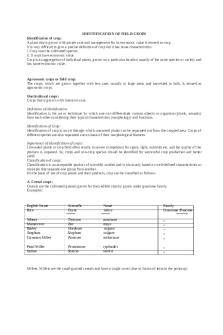LEcture 4 - t-tests - Professor Andy Field PDF

| Title | LEcture 4 - t-tests - Professor Andy Field |
|---|---|
| Course | Research Skills in Psychology 2 |
| Institution | University of Sussex |
| Pages | 8 |
| File Size | 589.4 KB |
| File Type | |
| Total Downloads | 112 |
| Total Views | 156 |
Summary
Professor Andy Field...
Description
LEcture 4 - t-tests -
-
Understanf what t tests are doing and when to use them To understand how to run and report the findings from an independent means t test in SPSS To understand how to run and report the findings from an dependent-means t test in SPSS Is there a ‘real’ difference between the two conditions (in a within subjects design) or two groups ( with a between subjects design) in my experiment → are there any differences between groups/conditions due to the manipulation of the IV Or is the difference due to chance - did the manipulation have no effect and any differences between groups/ conditions are just due to random factors Cant compare more than 2 numbers - 2 means
2 types of t test: a) Dependent means t test: MAtched pairs / paired samples / related / repeared measures t test - same subjects do all conditions (within subject design) b ) independent means - t test : Unrelated t test - different subjects do each experimental condition (between groups design) Both types of t-test have 1 independent varibale with 2 levels (two didfferent conditions of our experiemnt) There is one dependent variable (the thing we actually want to measure)
Null hypothesis Ho: Mean RT - always start by assuming the null hypothesis - no effect With the null hypothesis we assume that the reaction times from the two groups are samples from the same population (the same population of RT) Alternate hythesis (H1 or Ha) The mean RT when condition a or b The manipulation of the IV has had an effect If the Null is that the two samples come from the same population then ideally the sample means should be identical E.g differnce = 0 If this is the case then the difference must be due to chance - sampling variation
A big difference between our 2 sample means therefore suggests either : a) The two sample means are a poor reflections of the mean of the single population they are supposed to represent (i.e our samples are atypical ones) Or b) the two sample means are actually from 2 different parent populations and our inital assumption that the samples borh come from the same population is wrong The bigger the difference between our two sample means the less pluasable A becomes and more likely that B is true.
P value is under the colum titled significance Dependent means test spss - Analyse - compare means - paired samples - - ok
If means are really close together its unlikely to have of occured by chance
-
Perfect correlation is 1
Large difference between 2 means - small difference liekly to be due to chance large likely to be manipulation of IV
→ never report this part of table levines test - unique to independent t test → seeing if t test meets assumptions of other - data must show homegeneity of variance → want it to be non significant → if levines test was below .05 → means data isnt meeting assumption and should use non-parametric test → only report bottom line Dont report sign for t test - if negative just dont report
-
Remove outliers using z scores...
Similar Free PDFs

4.Andy Warhol - Appunti
- 2 Pages

Andy Bell - Lecture notes 1
- 9 Pages

Field 4 - Process Recording
- 6 Pages

Residue Testing - Andy Grist
- 3 Pages

Andy Warhol
- 2 Pages

Lecture 10 - Professor Pickering
- 6 Pages

Andy Corporation Solution
- 3 Pages

Chapter 4 - Professor Trone
- 4 Pages

Quiz 4 - Professor Dumon
- 5 Pages
Popular Institutions
- Tinajero National High School - Annex
- Politeknik Caltex Riau
- Yokohama City University
- SGT University
- University of Al-Qadisiyah
- Divine Word College of Vigan
- Techniek College Rotterdam
- Universidade de Santiago
- Universiti Teknologi MARA Cawangan Johor Kampus Pasir Gudang
- Poltekkes Kemenkes Yogyakarta
- Baguio City National High School
- Colegio san marcos
- preparatoria uno
- Centro de Bachillerato Tecnológico Industrial y de Servicios No. 107
- Dalian Maritime University
- Quang Trung Secondary School
- Colegio Tecnológico en Informática
- Corporación Regional de Educación Superior
- Grupo CEDVA
- Dar Al Uloom University
- Centro de Estudios Preuniversitarios de la Universidad Nacional de Ingeniería
- 上智大学
- Aakash International School, Nuna Majara
- San Felipe Neri Catholic School
- Kang Chiao International School - New Taipei City
- Misamis Occidental National High School
- Institución Educativa Escuela Normal Juan Ladrilleros
- Kolehiyo ng Pantukan
- Batanes State College
- Instituto Continental
- Sekolah Menengah Kejuruan Kesehatan Kaltara (Tarakan)
- Colegio de La Inmaculada Concepcion - Cebu






